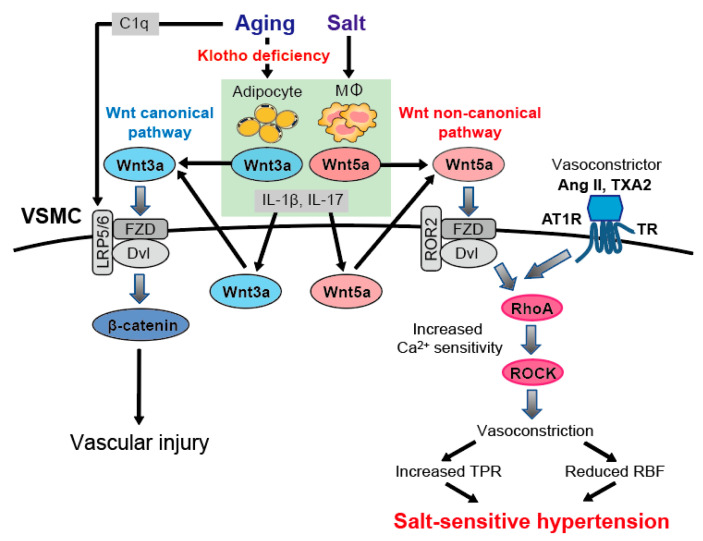Figure 3.
Potential mechanisms of aging-associated salt-sensitive hypertension and crosstalk between Wnt noncanonical pathway and angiotensin II (Ang II)-induced vasoconstrictive pathway. In aged mice with reduced serum klotho levels, high salt intake stimulates adipocytes and macrophages to produce cytokines such as IL-1β and IL-17, which in turn stimulate vascular smooth muscle cells (VSMCs) to secrete Wnt3a and Wnt5a. Inflammatory cytokines also upregulate Wnt5a expression in macrophages and adipocytes via paracrine and autocrine signaling. Secreted Wnt5a activates the noncanonical Wnt-RhoA (PCP) pathway by binding to its receptor Frizzled (FZD) and the Wnt coreceptor tyrosine-protein kinase transmembrane receptor ROR2 in VSMCs. Activated RhoA/Rho-associated protein kinase (ROCK) increases the Ca2+ sensitivity of VSMCs, leading to vasoconstriction. On the other hand, Ang II-induced RhoA/ROCK activation needs Wnt5a, and there is the crosstalk between Wnt noncanonical pathway induced- and Ang II-induced vasoconstriction in the process of RhoA activation. Consequently, total peripheral resistance (TPR) increases, and renal blood flow (RBF) decreases in the development of salt-sensitive hypertension. Aging-related salt-sensitive hypertension is thought to be related to increased vascular sensitivity to thromboxane A2 (TXA2) as well as Ang II. The canonical Wnt3a-β-catenin pathway is already enhanced with a normal salt diet, which might be a general feature of aging, regardless of klotho deficiency. Increased levels of complement C1q also activate the Wnt-β catenin pathway via cleavage of the Wnt coreceptors LRP5 and LRP6. High salt intake further increases Wnt3a-β-catenin signaling in the setting of klotho deficiency, leading to cardiac and vascular damage and arterial stiffness. Dvl, Dishevelled; LRP5/6, low-density lipoprotein receptor-related protein 5 and low-density lipoprotein receptor-related protein 6. We have modified this figure from our previous paper described below. This material is from: Wakako Kawarazaki and Toshiro Fujita, Kidney and epigenetic mechanisms of salt-sensitive hypertension, Nat Rev Nephrol, 2021, [Nature Springer] [37].

